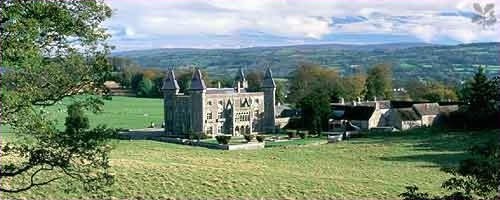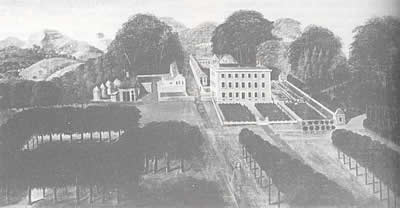The Dynevors
Dinefwr Park
As well as Dinefwr Castle detailed above, the modern Dinefwr Park consists of two other major features: Newton House and Castle Woods (with Llandyfeisant Church).
An 18th-century landscape park, enclosing a medieval deer park, Dinefwr is home to more than one hundred fallow deer and a small herd of Dinefwr White Park Cattle. A number of scenic walks are available including access to Dinefwr Castle, with fine views across the Towy Valley. There is also a wooded boardwalk, particularly suitable for families and wheelchair users. Newton House, built in 1660, but now with a Victorian façade and a fountain garden, is at the heart of the site. It has two showrooms open to the public, a tea-room which looks out onto the deer park and an exhibition on the history of Dinefwr in the basement. The National Trust website

There had been a manor house on the ancestral estate at Dinefwr Park since the 15th century but It was in 1775, at the time of Sir George Rice MP and father of the 3rd Baron, that the grounds were remodelled by Capability Brown in the fashion of the time - a carefully controlled 'wilderness' of sweeping parkland punctuated by groups of towering trees. Although the present Newton House dates back to 1660 and Sir Edward Rice - the great-great-great-great-great grandfather of the present Lord Dynevor - the house has substantial 18th-century and Victorian Gothic additions.

Newton House has had something of an unhappy recent history. It was sold by the present Lord Dynevor in 1974 and suffered badly thereafter, falling into near ruinous disrepair. It was occupied by squatters for some years and was stripped of many of its original features. (No more than two people at a time are allowed on the top floor because the structure has been weakened by the removal of beams and joists for firewood!)
Mercifully, both the medieval castle and Newton House have recently been restored by Cadw and the National Trust respectively, who now run the park, its buildings and a tea shop. Dinefwr Park is also open to the public. Check the National Trust website for opening times, admission prices etc. Since being restored to something resembling its former glory, Newton House has become an important feature of Llandeilo's cultural life, providing a superb setting for concerts and exhibitions as well as being licensed for civil weddings. The National Trust acquired the deer park and the outer park at Dinefwr in 1987. Newton House was purchased by the Trust in 1990 having been through several hands since first sold by Lord Dynevor in 1974. The East Drive was acquired in 1992. The generosity of the Heritage Lottery Fund facilitated the purchase of Home Farm and Penparc in 2002 and the site of a major Roman fort has since been discovered on the land, so an exciting prospect lies ahead when the site, hopefully, is excavated in the near future. Dinefwr is now 286 hectares in extent (707 acres), somewhat less than the 10,738 acres of 1883 but impressive nonetheless.
The organisation responsible for the Welsh architectural heritage is CADW (Cadw means 'to keep' in Welsh) who describe Newton House thus:
Newton Mansion continued to be occupied by the Rice (Rhys) family and was partly rebuilt between 1595 and 1603, again in c.1660, and in c. 1757-1779, and then in its present form in 1856-1858 by Richard Kyrke Penson, retaining many features from c.1660. The present landscape was emparked between c.1590 and c.1650 (Milne 1999, 6). The park walls were completed in c.1774 and enclosed a large landscaped area of over 200 hectares with a small formal garden, walled gardens and a suite of domestic structures. There are some remains of underlying landscapes, including an east-west terrace that may represent part of the Carmarthen-Llandovery Roman road, and traces of roads and trackways that may be Roman and/or Medieval. A Roman milestone and a coin hoard have also been recorded near Dinefwr Castle while sherds of amphorae and Samian ware have been found in the vicinity of Dinefwr Farm (Crane 1994, 6). The central part of the area includes the old parish church of St Tyfi, Llandyfeisant, which has Medieval origins. It is now redundant and used by the Wildlife Trust West Wales; the record … of 'Roman tesserae' beneath the church appears to be entirely erroneous.
Note
The architect of Newton House mentioned above, Richard Kyrke Penson, was also responsible for building the impressive lime kilns at the Cilyrychen Quarry in Llandybie in 1857, still visible from the main road, though no longer in use. Modern fertilisers have long put paid to the older practice of spreading lime on farm land.
Castle Woods and Llandyfeisant Church
Newton House and most of Dinefwr Park are owned and managed by the National Trust but the modern-day park also includes Castle Woods, Llandyfeisant Church and Dinefwr Castle which comprise the southern edge of the park, overlooking the river Towy. These are all owned by another public body, the West Wales Wildlife Trust, though another public body again - CADW, the Welsh ancient monument organisation - maintains Dinefwr Castle on their behalf.
The Castle Woods Nature Reserve has been described as "... one of the most exciting woodlands in South Wales" by no less an authority than Peter Crawford, a senior producer with the BBC's Natural History Unit, in his book 'The Living Isles.' "The woodland is primarily oak and wych elm," he writes. "The shrubs and ground cover are outstanding with cherry, holly, spindle, dog violet and the parasitic toothwort. Lichen communities are of importance and include the rare lungwort. Overlooked by the romantic Castle of Dinefwr the fine old parkland has a herd of fallow deer. The mature trees attract woodpecker, redstarts and pied flycatchers. In winter the water meadows draw large numbers of ducks." It's every bit as good as it sounds. The woods were purchased by the Wildlife Trust West Wales in 1979 and extend for dozens of acres along the steep slopes which rise from the Towy meadows up to the old Dinefwr Castle and to Penlan Park. The main access is from Penlan Park, but it's also possible to walk down the lane alongside the stone bridge over the Towy, following the marked paths indicated by the Badger footprint signs. Before long you'll come across Llandyfeisant Church, which lies in a delightful, sylvan, secluded setting at the heart of the reserve. (The name Llandyfeisant is a contraction of Llan Dyfi Sant - the church of St Dyfi.) This was regarded as the family church of the Lords of Dynevor, but had fallen into near-dereliction by the 1980s. It had ceased being used for worship in 1961 when its font and stained-glass window war memorial were removed to nearby St Teilo Church for safekeeping. This was not the first time, though, that the church had been allowed to fall into a ruinous state, and nor can the restless twentieth century carry the blame alone for the neglect of our architectural heritage, as the following inspection of Llandyfeisant church aptly demonstrates:
The Church consists of two aisles, the roof of the north aisle has no tiles upon it, the Timber which has been very good, & still might be of use, is expos'd to rot in the weather. The other aisle is very much decay'd in the tiling. In fair weather the Minister that assists at Llandeilo reads prayers here once every Sunday, but in wet weather he is forc'd to omitt them there being no convenient place in the Church for keeping him or the people dry. No Bible, Common-Prayer Book, Homilies, Canons, Table of Degrees, nor Register Book. My Lord Carbery who holds the Tithes as Tenant to the Bishop of Chester allows 40 shilling a year to the Minister. Question. whether any preaching? I believe not.
From an account of the results of an [ecclesiastical] visitation of 62 parishes within the archdeaconry of Carmarthen, 'A Visitation of the Archdeaconry of Carmarthen, 1710', published in The National Library of Wales Journal 1976, Summer XIX/3, by G. Milwyn Griffiths.
The date of the above 'visitation' (ie, inspection)? July and August of 1710. But by the 19th century the farm workers, retainers and servants of the rebuilt Newton House and Dynevor estate provided a sizeable congregation for Llandyfeisant church, which was completely rebuilt in the late Victorian period, as described in this survey by the Welsh ancient monument organisation, CADW :
Small stone church of medieval origin but almost entirely rebuilt in later C19, possibly to designs by R Kyrke Pearson, architect of Oswestry who redesigned Newton House for Lord Dynevor. Plan of unified chancel and nave with medieval (?) South aisle set back to left … Church of moderate architectural interest in an exceptional location at Dinefwr Park. Fine steeply sloping burial ground with old headstones

The church has since been restored with the help of unemployed labour from the Manpower Services Commission and served briefly as an information centre and shop in the 1990s, though it is currently locked. We may be a more secular age than back in 1710 but our lack of piety hasn't stopped us caring for our religious heritage any less. A few yards away from the church lie the ruins of what may be the former vicarage, open to the elements now, and untended graves scattered under the steadily encroaching trees lend the scene a melancholy air tinged with a little mystery. Not somewhere for those of a nervous disposition to find themselves as nightfall approaches, either